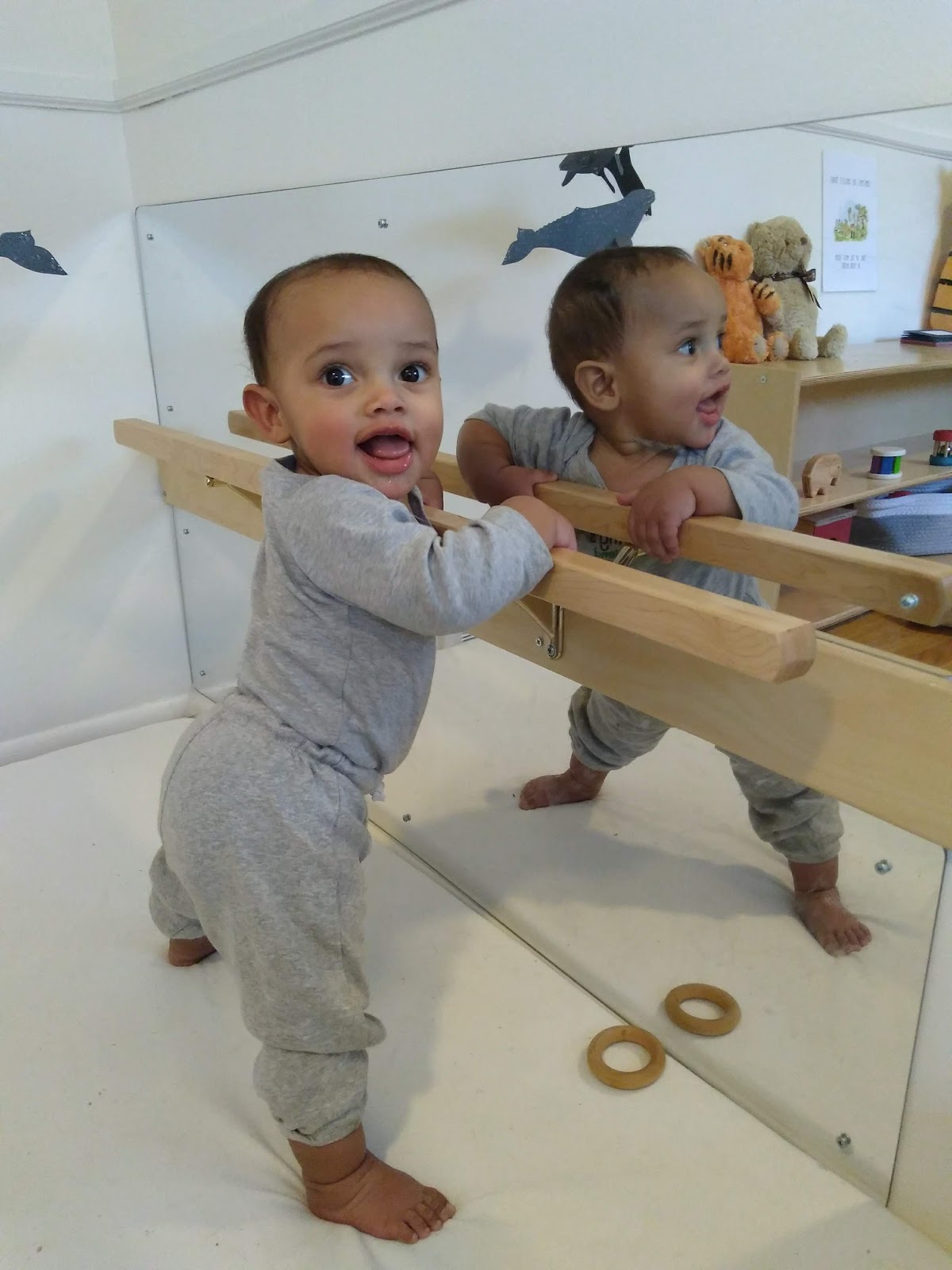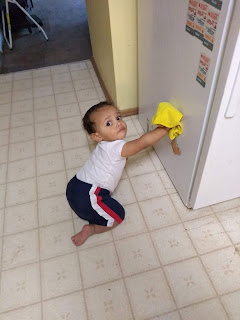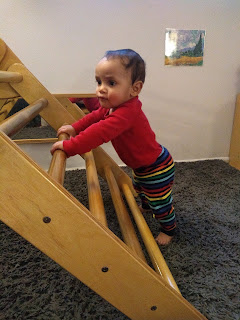Freedom of Movement
In my last post, I talked about the Montessori floor bed. Part of the reasoning behind a floor bed is to give the child freedom of movement, allowing him the independence to get in and out of bed. For the same reason, Montessorians try to avoid restricting the child’s movement in other ways as well. We try not to have the child in any sort of seat or confined space which he cannot get out of when he chooses. This means no playpens, no Bumbo chairs, no bouncy seats. From birth, we tried whenever possible to have Calvin on the floor so that he was free to move his arms, legs, and head around.
Of course, there are situations in which we must confine our child. In the car, for instance, a car seat to keep a child safe is obviously important. However, we chose a car seat that is permanently in the car rather than one that can pop out of a base so the child can be carried in the car seat. I wanted Calvin to be in a car seat for as little time as possible to allow him maximum freedom of movement. Being in a car seat too long can also have other negative impacts, so the AAP recommends infants spend no longer than 30 minutes at a time in a car seat. So instead of carrying Calvin around in his car seat, we would either just carry him in our arms or use an infant carrier (Ergobaby and ring sling were the two I used).


No cribs and no playpens...then how can you keep your baby safe? As mentioned in my floor bed post, once the baby is mobile it requires a lot of baby-proofing! We have locks on all our cabinets, our lamps are secured to the walls, we have a baby gate at the top of the stairs, and the list goes on. We also have to watch Calvin super closely. That hasn’t been much of an issue thus far, because for the most part he doesn’t like to let us out of his sight. If I need to go to the bathroom, he generally follows me in there and plays with the toilet paper or his hairbrush until I’m done. But there are times I feel like I am just chasing him around the house. Usually it’s at 5:00pm after work when I am exhausted and all he wants to do is get into the dog food and water and make a huge mess. I understand why parents would want to use a playpen in that situation; I really do. It would make things a lot easier. But I believe it is more respectful to my child to let him explore (with limits), and I also want to fully support his gross motor development.

Bouncers, activity chairs, etc. Don’t they seem like a lot of fun? Yes, I’m sure some of those swings and bouncers are a lot of fun for the child. However, it is still more beneficial to the child to have free movement than to be confined in some sort of seat. Some of the toys can actually inhibit normal development because instead of learning how to crawl or walk normally, a child might be learning how to crawl/walk in an unnatural position, such as a bouncy chair that lets a child’s legs dangle and scoot himself around.

But what about high chairs? Well, full disclosure: I am not 100% Montessori on this one. The true Montessori way would be no high chair. The child is confined into the chair and cannot get out, therefore it is not truly Montessori. Instead, Montessori families use a child-sized weaning table and chair which the child can get in and out of independently (more about this in a future post). Calvin does have a Montessori weaning table and chair which he uses for snacks throughout the day, but we do have a high chair at the dining room table which we use for family meals. My rationale is that I want Calvin to be included in family meals and a high chair is the most practical way to do that. However, I did try to go with the most “Montessori” style of high chair. We have a Tripp Trapp by Stokke, a Swedish brand. It is natural wood and instead of using a tray it pulls right up to the table so the child is truly a part of the family meal.


So there is a short explanation of our Montessori-informed attempt at giving Calvin freedom of movement. While there are obvious short-term benefits of constricting a baby or toddler to a crib, a playpen, a high chair, or a swing, I believe the long-term benefits of freedom of movement outweigh the inconvenience. We are doing our best to give Calvin optimal gross motor skill development, and even more importantly, independence.
One week old Calvin on his Topponcino, placed on his movement mat next to a mirror. Here he is looking at his Munari mobile.
Of course, there are situations in which we must confine our child. In the car, for instance, a car seat to keep a child safe is obviously important. However, we chose a car seat that is permanently in the car rather than one that can pop out of a base so the child can be carried in the car seat. I wanted Calvin to be in a car seat for as little time as possible to allow him maximum freedom of movement. Being in a car seat too long can also have other negative impacts, so the AAP recommends infants spend no longer than 30 minutes at a time in a car seat. So instead of carrying Calvin around in his car seat, we would either just carry him in our arms or use an infant carrier (Ergobaby and ring sling were the two I used).
Calvin at 11 days old in the ring sling at Zingerman’s Deli and at 2 weeks old in the Ergobaby at Washtenaw Dairy.
No cribs and no playpens...then how can you keep your baby safe? As mentioned in my floor bed post, once the baby is mobile it requires a lot of baby-proofing! We have locks on all our cabinets, our lamps are secured to the walls, we have a baby gate at the top of the stairs, and the list goes on. We also have to watch Calvin super closely. That hasn’t been much of an issue thus far, because for the most part he doesn’t like to let us out of his sight. If I need to go to the bathroom, he generally follows me in there and plays with the toilet paper or his hairbrush until I’m done. But there are times I feel like I am just chasing him around the house. Usually it’s at 5:00pm after work when I am exhausted and all he wants to do is get into the dog food and water and make a huge mess. I understand why parents would want to use a playpen in that situation; I really do. It would make things a lot easier. But I believe it is more respectful to my child to let him explore (with limits), and I also want to fully support his gross motor development.
Dog plus baby meant no ornaments on the bottom third of the tree--this year will be more difficult with a toddler!
Bouncers, activity chairs, etc. Don’t they seem like a lot of fun? Yes, I’m sure some of those swings and bouncers are a lot of fun for the child. However, it is still more beneficial to the child to have free movement than to be confined in some sort of seat. Some of the toys can actually inhibit normal development because instead of learning how to crawl or walk normally, a child might be learning how to crawl/walk in an unnatural position, such as a bouncy chair that lets a child’s legs dangle and scoot himself around.
One way to support healthy gross motor development is with a pull-up bar! Don’t have one? No problem! Calvin loved pulling up on coffee tables, windowsills, whatever! However, it was really nice having this awesome pull-up bar with a mirror when Calvin was first starting to stand (7 months).
But what about high chairs? Well, full disclosure: I am not 100% Montessori on this one. The true Montessori way would be no high chair. The child is confined into the chair and cannot get out, therefore it is not truly Montessori. Instead, Montessori families use a child-sized weaning table and chair which the child can get in and out of independently (more about this in a future post). Calvin does have a Montessori weaning table and chair which he uses for snacks throughout the day, but we do have a high chair at the dining room table which we use for family meals. My rationale is that I want Calvin to be included in family meals and a high chair is the most practical way to do that. However, I did try to go with the most “Montessori” style of high chair. We have a Tripp Trapp by Stokke, a Swedish brand. It is natural wood and instead of using a tray it pulls right up to the table so the child is truly a part of the family meal.
Calvin eating a snack of yogurt at his weaning table and eating a pancake breakfast with the family in his Tripp Trapp high chair.
So there is a short explanation of our Montessori-informed attempt at giving Calvin freedom of movement. While there are obvious short-term benefits of constricting a baby or toddler to a crib, a playpen, a high chair, or a swing, I believe the long-term benefits of freedom of movement outweigh the inconvenience. We are doing our best to give Calvin optimal gross motor skill development, and even more importantly, independence.




Comments
Post a Comment